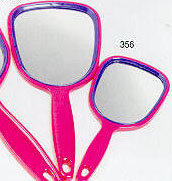
Mirrors

Mirror, Mirror on the Wall- A notepad sized mirror is placed at eye level against the wall. (I used a magnetic mirror that will stick to my white board to allow for easy adjustment.) Students are asked to move away from the mirror and notice how much of their faces they can see in the mirror at different distances.
How Much Mirror? Using a large mirror, the students partner marks on the mirror how much of the mirror is needed to for the student to see the entire body. This distance is measured, and the students height is measured. Compare these two measurements.
Kaleidoscope- Students are given two small square mirrors. These are placed at angles adjacent to one another. Place this setup over a protractor so that the angle between the mirrors can be measured. A pencil is placed between the mirrors and students count the number of images viewed and record the angle. At this station the students also find kaleidescopes containing mirrors placed a varying angles.
Curved Reflection- Take a slice of a large plastic pvc pipe (5-6" diameter) and glue a strip of mylar on each side. Have students place a piece of paper under the setup. Hold a single filament lightbulb near the concave side of the pipe, sketch the path of reflected light. Hold the bulb far, repeat. Repeat for the convex side.
Law of Reflection- Hold a single filament bulb so the light reflects off a flat mirror. Place a paper clip (bent so that it stands with one wire sticking up at a 90 degree angle) so that its shadow can be seen hitting and bouncing off the mirror. Trace the shadow and the front surface of the mirror. Construct a normal and measure angles of incidence and reflection.
Real Image-Mirror Mirage is a device available for about $40 at science museums and scientific supply companies. You can make one for two dollars which is a reasonable facsimile. At Michael's Craft Store before Christmas look for silver plastic ornaments (4")which divide in two. Cut about one inch off the bottom of one half, and cut a 3/4" hole in the top of the same half. Place this trimmed half into the other. Place some small object at the bottom of the untrimmed half, and observe from an angle. Tough the image!
Disappearing Money- Again a fun bank obtained a t a toy store. The bank contains a mirror which causes the money dropped in to "disappear".
Silver Spoons- Have students look into a curved mirror, or spoon if nothing else is available. Have them describe the image seen close, far, concave and convex. Students should indicate size and orientation.